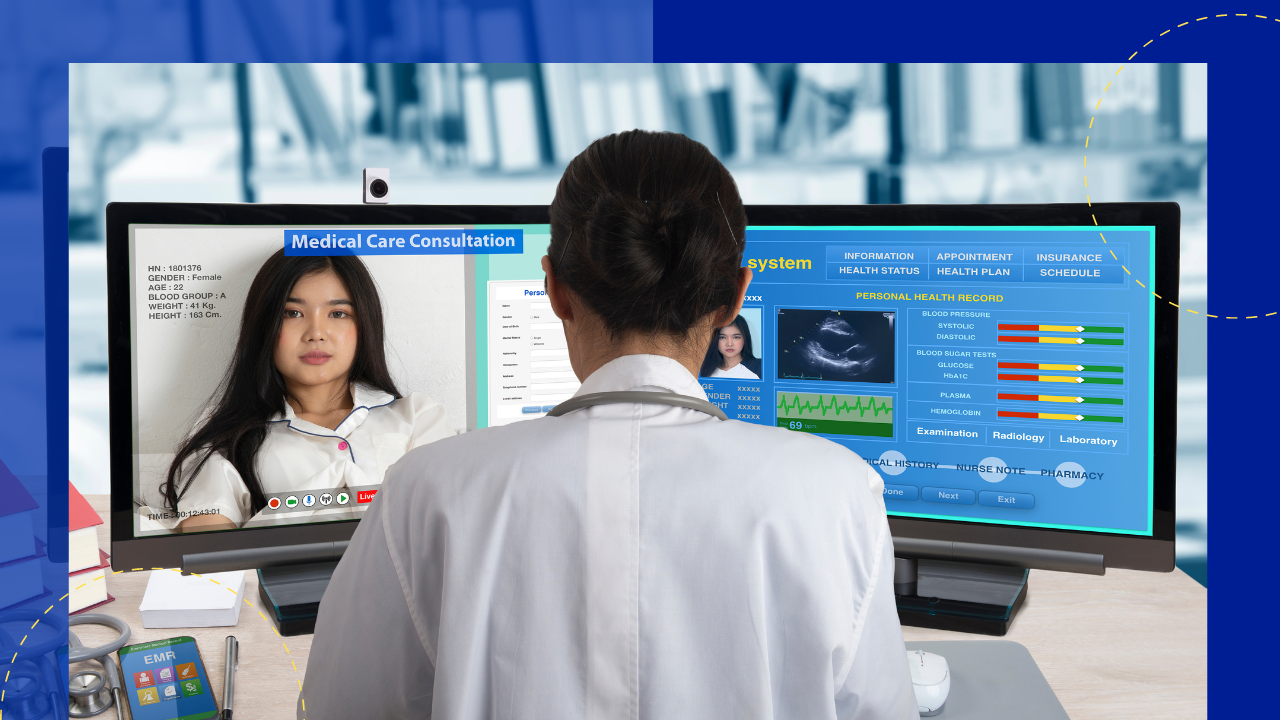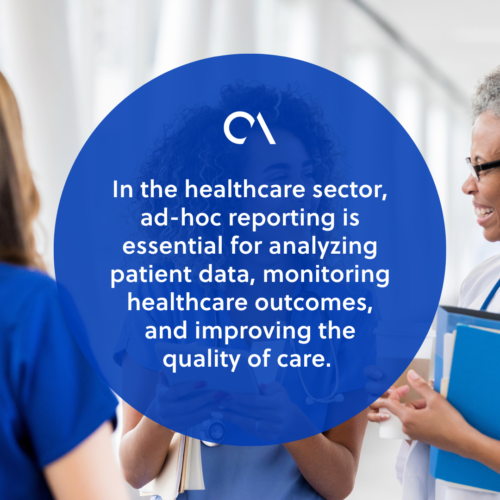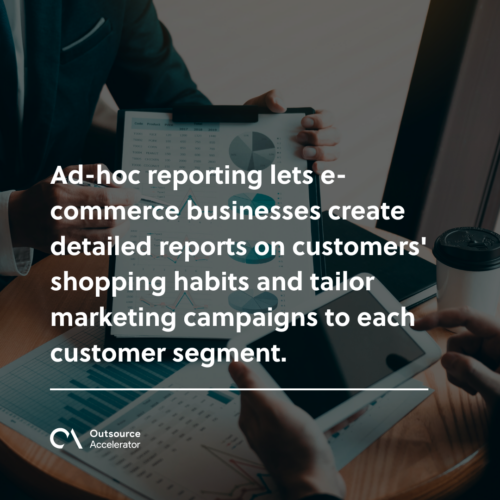The power of ad-hoc reporting and analysis in business intelligence

As the world gets more digital, businesses generate vast amounts of data from various sources.
If used properly, data holds valuable insights that can drive decision-making, optimize processes, and improve overall performance.
In fact, we create 2.5 quintillion bytes of data every day. According to Forbes, we’ve generated 90% of the world’s data in just the past few years.
That’s why organizations rely on business intelligence (BI) tools to harness the power of data. Within BI, ad-hoc reporting and analysis play a crucial role.
Let’s delve into what ad-hoc reporting is, its applications, benefits, challenges, and how to implement it effectively.
What is ad-hoc reporting?
Ad-hoc is a Latin term that means ‘as needed’ or ‘as required.’ With that in mind, ad-hoc reporting is the process of creating customized reports on demand.
It allows users to extract specific information from the company’s data without the need for predefined templates.
Ad-hoc reporting empowers business users to access real-time data, explore trends, and analyze critical insights. It does so without relying on technical experts or waiting for scheduled reports.
It also offers a level of flexibility and agility that pre-built reports cannot match.

Defining ad-hoc analysis
Ad-hoc analysis complements ad-hoc reporting by letting users conduct deeper explorations and investigations into data. It is unlike reporting, which focuses on presenting information in a structured format.
Ad-hoc analysis empowers users to ask spontaneous questions and conduct multidimensional analysis to uncover hidden patterns, correlations, and trends.
Ad-hoc reporting vs. Canned reports
Canned reports, also known as static or pre-built reports, are predefined reports created by IT or data analysts based on common business needs.
Static reports are useful for regular and repetitive reporting needs. While they offer consistency and speed, they may not cater to the unique requirements of individual users or specific situations.
Ad-hoc reporting, on the other hand, allows users to create custom reports tailored to their specific needs. It provides greater control and insight into the data.
Where is ad-hoc reporting used?
Ad-hoc reporting can be applied in various business domains. Let’s explore some of the key areas where it is widely used:
Finance reporting
In the finance industry, ad-hoc reporting plays a part in financial analysis, budgeting, and forecasting.
Financial professionals often require real-time access to financial data to:
- Analyze performance metrics
- Identify areas for improvement
- Make data-driven decisions
Impromptu reporting allows them to drill into complex financial data and generate custom reports. These reports would provide deeper insights into revenue, expenses, and profitability.
Sales and retail reporting
Sales teams, retailers, and e-commerce businesses benefit greatly from ad-hoc reporting. They can analyze sales data by product, region, customer segments, or time periods.
Following analysis, ad-hoc reports can help:
- Identify sales trends
- Compare sales figures
- Forecast demand
- Optimize pricing strategies
- Research customer demographics
Reporting as needed empowers sales and retail professionals to respond quickly to changing market dynamics and make informed decisions to drive revenue growth.
Human resources reporting
Ad-hoc reporting plays a vital role in human resources (HR) management. HR departments deal with a vast amount of employee-related data, including performance, attendance, and workforce analytics.
With that data, HR professionals can use ad-hoc reports to:
- Evaluate employee performance
- Track training and development initiatives
- Analyze workforce trends
For example, on-demand reporting can generate custom reports on employee turnover rates. HR managers can then identify potential retention issues and take proactive measures to address them.
Healthcare reporting
In the healthcare sector, ad-hoc reporting is essential for analyzing patient data, monitoring healthcare outcomes, and improving the quality of care.
Healthcare professionals can generate custom reports to:
- Track patient populations
- Assess treatment effectiveness
- Identify potential areas for improvement
Ad-hoc reporting lets healthcare organizations analyze vast amounts of data and make data-driven decisions to enhance patient outcomes.

Government reporting
Ad-hoc reporting is valuable for analyzing public services, policy-making, and resource allocation data in government agencies.
It allows government officials to generate tailored reports to:
- Monitor key performance indicators (KPIs)
- Track spending
- Identify areas for improvement in various sectors
Education reporting
In the field of education, ad-hoc reporting can help analyze student data, assess academic performance, and evaluate the effectiveness of educational programs.
Educators can generate ad-hoc reports to:
- Track student progress
- Identify areas of intervention
- Make informed decisions to improve teaching methodologies and student outcomes
Manufacturing reporting
Ad-hoc reporting is beneficial in the manufacturing industry for examining production data, optimizing processes, and ensuring quality control.
Manufacturers can create specialized reports to monitor production volumes, defect rates, and equipment utilization.
Ad-hoc reports let manufacturers:
- Identify inefficiencies
- Address bottlenecks
- Make data-driven decisions to boost operational efficiency
Customer service reporting
Ad-hoc reporting can interpret customer service data and improve the customer experience.
Customer service teams can make ad-hoc reports to track key metrics like response times, customer satisfaction ratings, and issue resolution rates.
This type of reporting enables those in customer support to:
- Identify patterns
- Spot areas for improvement
- Make informed decisions to enhance the quality of customer service
Benefits of ad-hoc reporting
Ad-hoc reporting offers several advantages that contribute to its popularity in the business intelligence landscape:
- Real-time insights. Ad-hoc reporting provides access to real-time data. It lets businesses respond quickly to changing market conditions and emerging opportunities.
- Customization. Users can tailor reports according to their specific needs. Ad-hoc reports ensure the information presented is relevant and actionable.
- Data exploration. Reporting as needed allows users to dissect data and explore various dimensions, uncovering hidden insights and trends.
- Better decision-making. With instant access to relevant data, decision-makers can make informed and data-driven choices.
- Increased agility. On-demand reporting fosters agility in decision-making processes. Therefore, it reduces dependency on IT or data analysts for regular reports.
- Enhanced collaboration. Ad-hoc reporting tools often support collaborative features, enabling teams to collaborate and share insights more effectively.
Challenges of ad-hoc reporting
While ad-hoc reporting brings numerous benefits, it also comes with some challenges that organizations must address:
- Data integrity and quality. Impromptu reporting relies on accurate and reliable data. Organizations must ensure data integrity and quality to avoid drawing incorrect conclusions.
- Data security. Providing access to sensitive data for on-demand reporting can raise security concerns. Businesses must implement robust security measures to protect confidential information.
- Data governance. Ad-hoc reporting requires strong data governance practices to ensure quality, accuracy, and consistency. This involves establishing proper guidelines and processes and ensuring compliance with regulatory requirements.
- Technical expertise. Associated tools may require technical proficiency to navigate and effectively utilize their features. Training and support may be necessary for users to maximize the benefits.
- Performance impact. Running ad-hoc queries on large datasets can impact system performance. Optimizing data infrastructure is necessary to maintain smooth operations.
- Time-consuming analysis. On-demand reporting often involves extensive analysis of data. Users may spend too much time exploring and manipulating data. It can delay decision-making and hinder efficiency in time-sensitive situations.
Examples of ad-hoc reporting
To better understand the practical applications of ad-hoc reporting, here are some examples:
Smarter marketing
Picture a team of marketers at a trendy fashion brand. They use ad-hoc reporting to unlock valuable insights from their data treasure trove.
With custom reports, they discover that their recent social media campaign featuring eco-friendly clothing is gaining significant traction among environmentally conscious customers.
Armed with this knowledge, they invest more in sustainable fashion lines and target specific customer groups, boosting brand loyalty and sales.
Efficient inventory management
Imagine a bustling retail store that never wants to run out of customers’ favorite products. Thanks to ad-hoc reporting, the store manager can quickly generate custom reports on sales trends and stock levels.
With this information, they know precisely when to reorder popular items. This lets the store avoid empty shelves and ensures customers always find what they need.
Better customer understanding
Step into the shoes of an e-commerce giant aiming to personalize shopping experiences. Ad-hoc analysis helps them delve into vast customer data to create detailed reports on shopping habits.
They discover that certain age groups prefer specific products and promotions. They tailor marketing campaigns with customer segments to resonate with each group. This creates a more meaningful shopping journey for every customer.

Staying safe
Imagine a construction site where safety is paramount. Ad-hoc reporting empowers the safety team to generate reports on incidents and near-misses.
They spot patterns indicating potential hazards and proactively address safety concerns. This vigilance ensures that every worker returns home safely after a day’s work.
Making products better
A product manager aims to create the best user experience. Ad-hoc reporting allows them to gather insights from customer feedback and sales data.
Tailored reports highlight potential product enhancements and preferences of different customer groups. The product manager uses the gathered information to work with the design and development teams.
As a result, they craft a superior product that exceeds customer expectations.
How to implement ad-hoc reporting
Effective ad-hoc reporting requires careful planning and execution. Here are some steps to consider:
- Select the right ad-hoc reporting tool. Select a tool that fits your firm’s needs and capabilities. Consider factors such as ease of use, scalability, data connectivity, and collaboration features.
- Ensure data integrity. Establish data governance practices to ensure data quality, accuracy, and consistency. Implement data validation processes and regularly monitor the integrity of your data sources.
- Provide training and support. Equip users with the necessary skills to utilize the ad-hoc reporting tool effectively. Offer training programs and resources to ensure users can fully leverage the tool’s capabilities.
- Implement data security measures. Establish data security protocols to protect sensitive information. Encrypt data, implement user access controls, and regularly audit system logs to prevent unauthorized access.
- Optimize performance. Monitor system performance to identify potential bottlenecks or areas for improvement. Optimize queries, consider data caching strategies, and evaluate hardware requirements for the best performance.







 Independent
Independent




